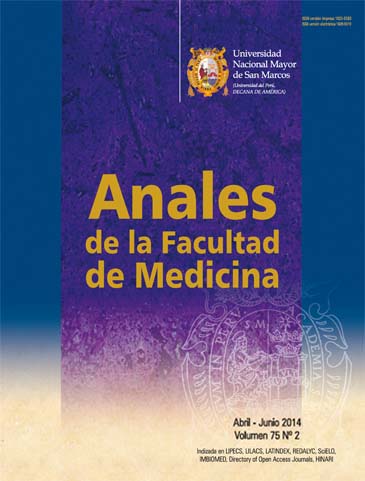Response to Graves-Basedow Disease treatment in pediatric patients
DOI:
https://doi.org/10.15381/anales.v75i2.8385Keywords:
Hyperthyroidism, goiter, treatmentAbstract
Objectives: To describe the clinical and biochemical response to treatment of hyperthyroidism. Design: Retrospective study. Setting: Instituto Nacional de Salud del Niño, Lima, Peru. Participants: children. Methods: From 1996 to 2007 32 patients with diagnosis of hyperthyroidism were studied. Remission was defined when patients were asymptomatic and biochemically euthyroid 6 months after the end of treatment; relapse when altered hormone levels were found after this period of time. Main outcome measures: Remission or relapse following treatment. Results: Mean age at diagnosis was 10.5 years (3.2-17.9 years), 26 patients (81.2 %) were female; 13 (40.6 %) were pubertal and 18 (59.3%) prepubertal. The most frequent symptoms and signs were: goiter, sweating, nervousness, weight loss, tachycardia and exophthalmos. Methimazole was used as first therapeutic option. Initial dose was 0.78mg/kg/day (0.41-2mg/kg/day) average. TSH (57.1%) and FT4 (50%) reached normal values between 6 and 8 months. Remission was observed in 11 patients (34.3%), 3 (9.3%) relapsed, 12 (37.5%) then received treatment with radioiodine (I-131) and 6 (18.7%) continued receiving methimazole. Remission was achieved after 2.81 ± 0.91 years of treatment (range 1.5-4.8), 4.1% after the first year, and 35.3 %, 37.5 % and 25 % respectively after the second, third and fourth year of treatment. Average age of those receiving I-131 was 14.6 years (7.1-19.6 years), at a dose about 7mCi; 75% of them showed remission after 0.64 ± 0.60 year (range 0.16-1.5 years). Conclusions: Hyperthyroidism due to Graves disease is relatively common in children. Remission was obtained in 34.3% of patients treated with methimazole in 2.81 ± 0.91 years average and remission was achieved in 75% of patients treated with I131, in 0.64 + / - 0.60 years average.Downloads
Published
2014-06-16
Issue
Section
Trabajos originales
License
Copyright (c) 2014 Martha Calagua Quispe, Oswaldo Núñez Almache, Juan Falen Boggio, Carlos Del Aguila Villar, Rómulo Lu de Lama, María Isabel Rojas Gabuli, Eliana Chávez Tejada, Oscar Espinoza Robles, Paola Pinto Ibarcena

This work is licensed under a Creative Commons Attribution-NonCommercial-ShareAlike 4.0 International License.
Those authors who have publications with this magazine accept the following terms:
- Authors will retain their copyrights and guarantee the journal the right of first publication of their work, which will be simultaneously subject to Creative Commons Attribution License that allows third parties to share the work as long as its author and its first publication this magazine are indicated.
- Authors may adopt other non-exclusive licensing agreements for the distribution of the version of the published work (eg, deposit it in an institutional electronic file or publish it in a monographic volume) provided that the initial publication in this magazine is indicated.
- Authors are allowed and recommended to disseminate their work over the Internet (eg: in institutional telematic archives or on their website) before and during the submission process, which It can produce interesting exchanges and increase quotes from the published work. (See El efecto del acceso abierto ).
How to Cite
1.
Calagua Quispe M, Núñez Almache O, Falen Boggio J, Del Aguila Villar C, Lu de Lama R, Rojas Gabuli MI, et al. Response to Graves-Basedow Disease treatment in pediatric patients. An Fac med [Internet]. 2014 Jun. 16 [cited 2025 Jun. 3];75(2):131-6. Available from: https://revistasinvestigacion.unmsm.edu.pe/index.php/anales/article/view/8385



